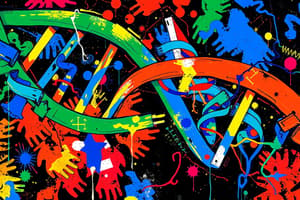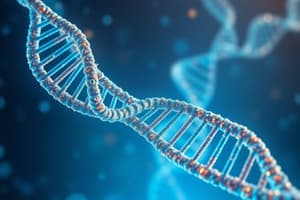Podcast
Questions and Answers
What is the primary role of transfer RNAs (tRNAs) in protein synthesis?
What is the primary role of transfer RNAs (tRNAs) in protein synthesis?
- They codify for proteins.
- They form the ribosomal structure.
- They act as adaptors between mRNA and amino acids. (correct)
- They regulate gene expression.
Which of the following statements best describes the differences between prokaryotic and eukaryotic DNA?
Which of the following statements best describes the differences between prokaryotic and eukaryotic DNA?
- Eukaryotic DNA is larger and arranged on chromosomes located in the nucleus. (correct)
- Prokaryotic DNA is more complex due to the presence of histones.
- Prokaryotic DNA is found in the nucleus, while eukaryotic DNA is located in the cytoplasm.
- Eukaryotic DNA is smaller and circular, while prokaryotic DNA is larger and linear.
What type of bond connects complementary nitrogenous bases in DNA?
What type of bond connects complementary nitrogenous bases in DNA?
- Disulfide bonds
- Ionic bonds
- Hydrogen bonds (correct)
- Covalent bonds
Which of the following is NOT a type of RNA produced in cells?
Which of the following is NOT a type of RNA produced in cells?
During cell division, chromosomes are formed from which cellular structure?
During cell division, chromosomes are formed from which cellular structure?
What distinguishes the B form of DNA from the other forms?
What distinguishes the B form of DNA from the other forms?
Why is antiparallel arrangement essential for DNA replication?
Why is antiparallel arrangement essential for DNA replication?
What role did Rosalind Franklin play in the discovery of DNA's structure?
What role did Rosalind Franklin play in the discovery of DNA's structure?
Which of the following correctly describes a characteristic of nucleotides?
Which of the following correctly describes a characteristic of nucleotides?
How many base pairs does the A form of DNA contain compared to the B form?
How many base pairs does the A form of DNA contain compared to the B form?
Flashcards
Phosphodiester Bond
Phosphodiester Bond
A type of bond that links the sugar and phosphate groups of adjacent nucleotides in a DNA or RNA molecule.
Chargaff's Rule
Chargaff's Rule
The rule stating that adenine always pairs with thymine (or uracil in RNA), and guanine always pairs with cytosine during DNA replication.
DNA Replication
DNA Replication
The process by which a copy of DNA is made, ensuring each daughter cell inherits a complete set of genetic material.
mRNA
mRNA
Signup and view all the flashcards
rRNA
rRNA
Signup and view all the flashcards
What is DNA?
What is DNA?
Signup and view all the flashcards
What is the structure of DNA?
What is the structure of DNA?
Signup and view all the flashcards
What does it mean that DNA strands are antiparallel?
What does it mean that DNA strands are antiparallel?
Signup and view all the flashcards
What is base pairing in DNA?
What is base pairing in DNA?
Signup and view all the flashcards
What is RNA?
What is RNA?
Signup and view all the flashcards
Study Notes
DNA and RNA Composition and Structure
- Nucleic acids are biopolymers, large biomolecules made of monomers called nucleotides.
- Two types of nucleic acids:
- Deoxyribonucleic acid (DNA)
- Ribonucleic acid (RNA)
History of DNA
- Genetic research began with Gregor Mendel, the "Father of Genetics," who experimented with plants in 1857.
- DNA was first observed by Friedrich Miescher in 1869.
DNA Structure
- DNA is a double-stranded helix.
- James Watson and Francis Crick determined the 3-dimensional structure of DNA in 1953, based on Rosalind Franklin's work.
DNA Composition
- DNA is a long polymer made of repeating nucleotides.
- Nucleotides consist of a sugar (deoxyribose), a phosphate group, and a nitrogenous base.
- Nitrogenous bases in DNA: Adenine (A), Thymine (T), Guanine (G), Cytosine (C)
- Base pairs:
- Adenine pairs with Thymine (A-T)
- Guanine pairs with Cytosine (G-C)
- The base pairs form a spiral staircase in the interior of the double helix.
- Hydrogen bonds connect the base pairs. Millions of weak hydrogen bonds hold the two strands together in the DNA double helix.
Forms of DNA
- B-form: Right-handed helix with 10 base pairs per turn (described by Watson and Crick).
- A-form: More compact than B-form.
- Z-form: Left-handed helix and bases are positioned more toward the periphery.
DNA Orientation
- Strands run from 5' to 3' and are antiparallel. This arrangement is necessary for DNA replication.
Chemical Bonds in DNA
- Covalent bonds: Between sugar and phosphate groups of two nucleotides (phosphodiester bonds).
- Hydrogen Bonds: Between complementary nitrogenous bases.
DNA in Prokaryotes and Eukaryotes
- Prokaryotic DNA: Smaller, circular, located in the cytoplasm.
- Eukaryotic DNA: Larger, arranged on chromosomes, located in the nucleus.
DNA vs RNA
- DNA:
- Site: Nucleus
- Sugar: Deoxyribose
- Nucleotides: A, T, G, C
- Arrangement: Double helix
- Types: One
- Synthesis: By replication
- Function: Storage and transfer of genetic and hereditary characters
- RNA:
- Site: Cytoplasm
- Sugar: Ribose
- Nucleotides: A, U, G, C (Uracil replaces Thymine)
- Arrangement: Single helix
- Types: mRNA, tRNA, rRNA
- Synthesis: By transcription
- Function: Protein synthesis by translation
DNA Denaturation and Renaturation
- Denaturation: Alkali or heat causes the DNA strands to separate.
- Renaturation: If DNA strands are separated (by heat), and the temperature decreases, base pairs reform, and the complementary strands come back together.
- Hybridization: A single strand of DNA or RNA pairs with complementary bases on another strand.
Mitochondrial DNA
- Mitochondrial DNA (mtDNA) is a double-stranded circular DNA molecule in the mitochondrial matrix.
- mtDNA has a different genetic code than genomic DNA.
- mtDNA codes for 13 protein subunits of the electron transport chain, a large and small ribosomal RNA (rRNA), and 22 transfer RNAs (tRNAs).
- mtDNA is maternally inherited.
- mtDNA has a higher mutation rate than nuclear DNA. (about 5-10 times higher).
Studying That Suits You
Use AI to generate personalized quizzes and flashcards to suit your learning preferences.





